Vous êtes ici : Accueil › Isotopes stables de l'eau des précipitations dans le sud du plateau tibétain : observations et modélisation
Isotopes stables de l'eau des précipitations dans le sud du plateau tibétain : observations et modélisation
Publication issue des travaux du projet PLUIES-TIBET.
Les auteurs ont mesuré la composition isotopique de précipitations collectées dans les régions de Bomi et Lhassa (plateau Tibétain). Ils ont par la suite évalué la capacité de deux modèles climatiques à reproduire la variabilité des précipitations dans ces régions, à l'échelle de l'événement et de la saison.
Les modèles à basse résolution et sans guidage par des champs de vent réels donnent des mauvais résultats en termes de température et de distribution des précipitations. Avec une maille plus fine (50km*50km) et un guidage par les champs de circulation atmosphérique réels, on obtient de meilleurs résultats.
Ces travaux soulignent l'intérêt d'utiliser les données de composition isotopique des précipitations, dans la région du sud du plateau tibétain, pour évaluer la performance des modèles climatiques.
Résumé en anglais
Precipitation water stable isotopes in the south Tibetan Plateau: observations and modeling
Measurements of precipitation isotopic composition have been conducted on a daily basis for one year at Bomi, southeast Tibetan Plateau, an area affected by the interaction of southwest monsoon, the westerlies and Tibetan high pressure systems, and at Lhasa, situated West of Bomi. The measured isotope signals are analyzed both on an event basis and on a seasonal scale using available meteorological information and air mass trajectories. The processes driving daily and seasonal isotopic variability are investigated using multi-decadal climate simulations forced by 20th century boundary conditions and conducted with two different isotopic atmospheric general circulation models (LMDZiso and ECHAM4iso). Both models use specific nudging techniques to mimic observed atmospheric circulation fields. The models simulate a wet and cold bias on the Tibetan Plateau together with a dry bias in its southern part. A zoomed LMDZ simulation conducted with ~50 km local spatial resolution dramatically improves the simulation of isotopic compositions of precipitation on the Tibetan Plateau. Simulated water isotope fields are compared with our new data and with previous observations, and regional differences in moisture origins are analysed using backtrajectories. Here we focus in particular on relationships between the water isotopes and climate variables on an event and seasonal scale and in terms of spatial and altitudinal isotopic gradients. Enhancing the spatial resolution is crucial for improving the simulation of the precipitation isotopic composition.
Gao et coll.; Journal of Climate ; Décembre 2010







